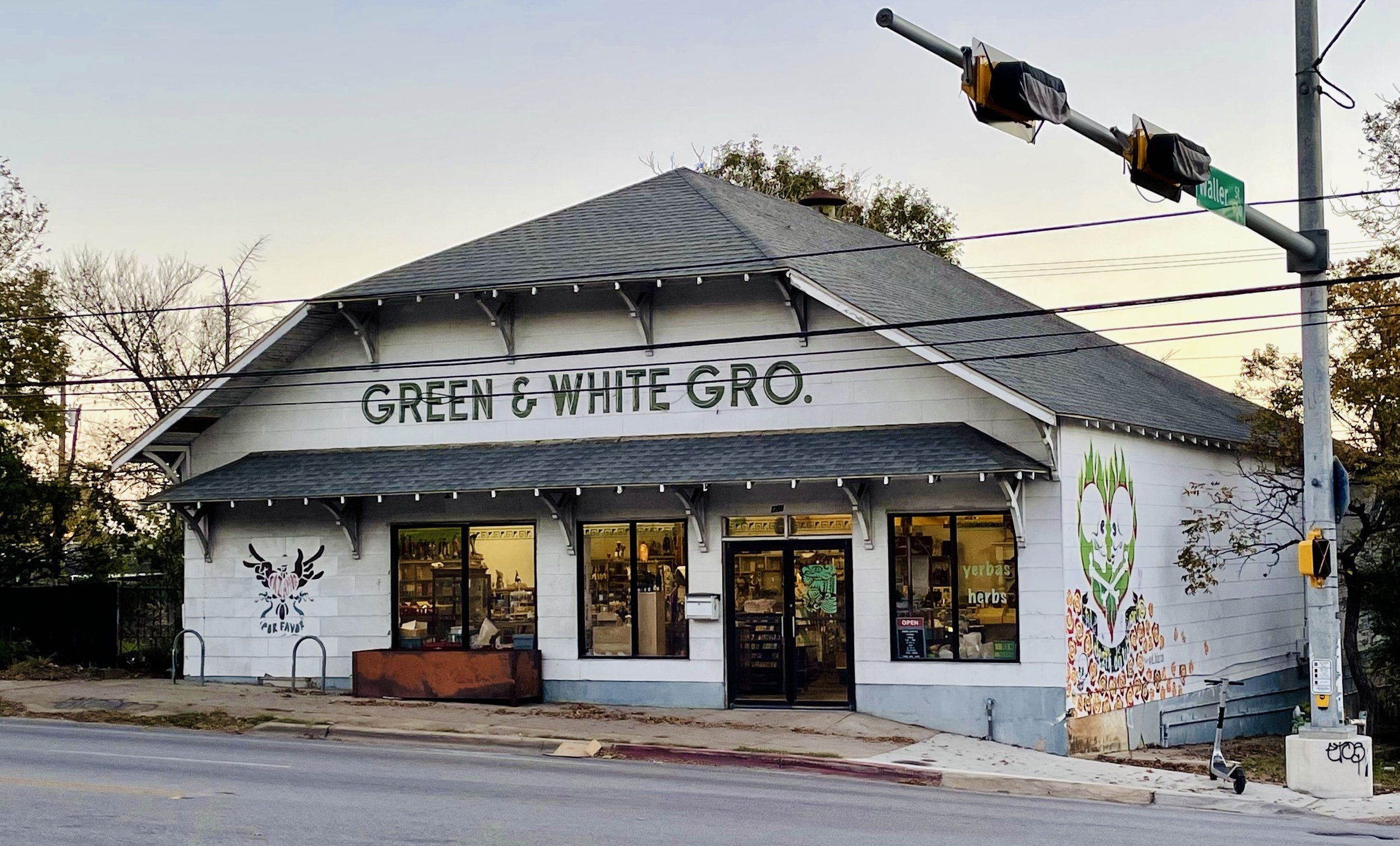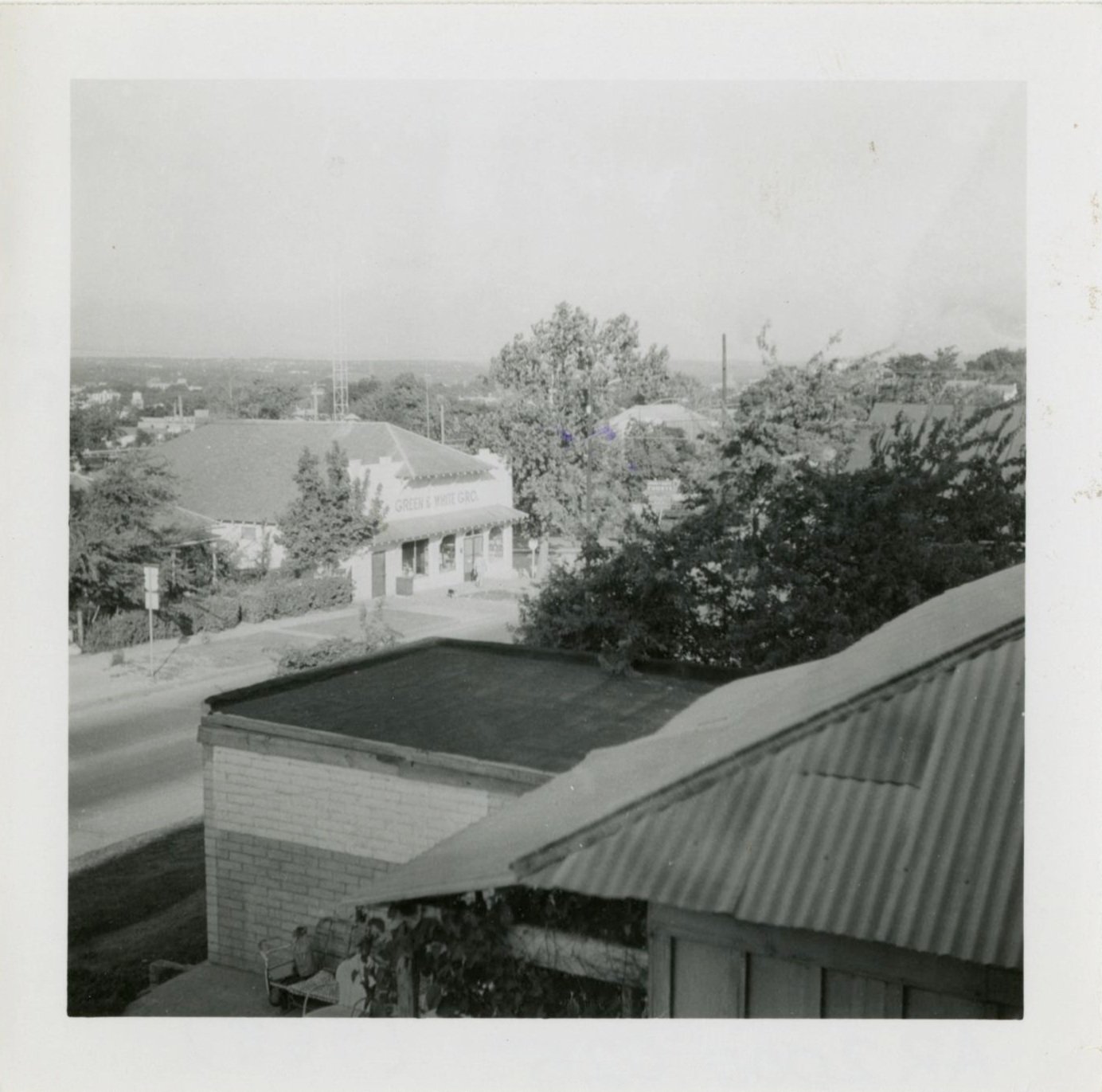Green & White Grocery
This post is a part of our East Austin Barrio Landmarks Project honoring the historic and cultural significance of East Austin's Mexican American community. For more information on the project—including our complete blog series and self-guided tour—click here.
Green & White Grocery, 1936
Nestled on the Corner of Waller Street & East 7th Street Sits a Beloved East Austin Staple Called Green & White Grocery
BY CATALINA CHERÑAVVSKY SEQUEIRA
The unknowing traveler might be surprised to find anything but a grocery. Though it might not be what they were looking for, many who wander in say it is exactly the kind of place they needed.
Upon walking into Green & White, you find a store packed with spiritual goods and colorful decor, and smell the air filled with incense. John Cazares sits at the cash register with a friendly and approachable aura greeting his customers, many of whom walk straight up to him to ask “I need this…” or “I’m looking for that…”. Once inside, it is hard not to be caught up by everything there is to look at, and many customers who expect to be in and out quickly are drawn in to browse the store just a few minutes longer to look at the medicinal remedies available for any malady and items that promote general health and wellbeing.
Green & White Grocery has been in the same family for three generations. In 1936, Norverto Lopez and his wife Susie purchased land to build a neighborhood grocery across Waller Street from their other business, the Green & White Courts motel. Much of the grocery building is likely made from recycled wood from the downtown lumberyard where Norverto worked part-time, and for the decor he stuck to his brand and favored color scheme. The family lived in an apartment at the back of the store until building a home across the street by their motel. Once the motel and grocery started to gain traction, the Green & White enterprise became Norverto’s full-time job and the store became a go-to for imported Mexican goods and delicious tamales.
Its location was largely influenced by the city’s transportation routes. The local buses on the East 7th Street bus route transported many East Austin residents to their jobs in other parts of the city including downtown and West Austin, stopping by Green & White Grocery along the way. The store was also one of the last locales on the highway heading out of Austin, making it an ideal location for the business and for anyone needing a quick pit stop before traveling into or out of the city.
Green & White Grocery, July 15, 1958 (Austin History Center via Portal to Texas History)
Norverto came from a large family based in Austin. He was one of nine siblings and had three children: Carlos, Olga, and Gertrude. His wife Susie passed away when their children were young, and Norverto later remarried. Gertrude “Gertie” Lopez would go on to marry Travis County commissioner and prominent Austin politician Richard Moya, and Olga Lopez married John Cazares, Sr. in 1955.
Olga met John Sr. when he worked at Green & White Grocery while a student at Austin High. They both had attended Palm School and were members of Our Lady of Guadalupe Church. Upon Norverto’s death in 1971 at the age of 65, Olga and John Sr. inherited the family store. They furthered the store’s reputation for having the best handmade tamales in Austin and added a full meat market and produce section as well. Their famous tamales attracted hundreds of customers every year, particularly around Christmas. Locals had to place orders for the Mexican delicacy months in advance for the wintertime.
John Sr. and Olga’s family grew, not just with their six kids but with members of the community as well. John Sr. was a father figure to many in the neighborhood. He helped people who were down-and-out and gave them a job, always assisting those who needed support. He gave credit to customers who could not afford to pay and arranged grocery deliveries for elderly customers. Due to widespread discrimination, minority communities, including Mexican American citizens, struggled to get credit at stores or be entrusted to pay their dues. Green & White provided a safe and welcoming space, where people knew that John Sr. treated everyone with respect.
Green & White Grocery Today
The grocery maintained its notoriety for delicious and hard to come by foods for several decades. In 1993, John Sr. retired and passed the store onto his son, John Cazares Jr. John transformed the store from a grocery to a botanica in 1996, selling votive candles, charms, perfumes, oils, herbs, vitamins, and other spiritual goods to promote a healthy lifestyle. John decided to keep the store name, both out of convenience but also because of its historic importance.
By the 1990s, Green & White was an emblem of the neighborhood. Everyone knew about it, and keeping the name the same just seemed natural. However, “the Botanica”' has become the unofficial name for the store and what many refer to it as. It is even how the store is labeled on Travis County records. The back space, formerly the Lopez’s family home when they started the business, served as a place where community members conducted cleansings, rituals, and blessings for several years. Now it is used as a personal space, but there are still those that visit the store not only to buy products or consult John for medicinal and spiritual queries, but also to pray to the various santos situated throughout the aisles.
Green & White Grocery Today
Today, the building looks much like it did in 1936. Its massive jerkinhead gable is reminiscent of Craftsman style houses and the storefront still includes the same distinct signage. A more recent addition to the store can be seen on the front and side of the building. Local graffiti artist Federico Archuleta painted two of his iconic stencils onto the walls that read “Paz y amor ¡Por favor!” and “Til death do us part”.
Located just across the street from the Briones House and a mere five-minute walk from Our Lady of Guadalupe Church, Green & White continues to be one of the many East Austin institutions that are emblematic of the Mexican American community that they serve. In fact, the demographic of customers has not drastically changed despite the evolution of the store. Many who shopped at Green & White Grocery before 1996 continue to do so today. The store continues to be supported by loyal, regular customers who come in anywhere from once a week to once every other month. Though most products come from Mexico, many other Latin American cultures utilize similar spiritual goods, so even customers from Central America can find items at Green & White that they cannot find anywhere else in Austin. Nevertheless, with Austin rapidly growing and changing John has noticed an influx of young people who come into his store, and the Mexican American majority demographic has diminished over the years. Just as people found comfort in the food and services of the grocery store for several years, many customers, both old and new, continue to find the same generosity and support at Green & White today.
-
Cazares, John. Personal interview. February 4, 2022.
“City of Austin Historic Resources Survey, Final Report Volume I.” Austintexas.gov, Hardy∙Heck∙Moore, Inc., October 24, 2016. https://www.austintexas.gov/edims/document.cfm?id=231307.
Gandara, Ricardo. “Longtime Green & White Grocery owner remembered for kindness to all.” Austin American Statesman, September 1, 2012.
“In With the New,” Austin Chronicle, 1996.
La Botanica. East Austin Stories. November 16, 2010. https://www.youtube.com/watch?v=F9CKLoUIBqQ.
“Most Unassuming Spiritual Haven: Green & White Grocery.” Austin Chronicle, 2011. https://www.austinchronicle.com/best-of-austin/year:2011/poll:critics/category:shopping/green-and-white-grocery-most-unassuming-spiritual-haven/.
The History of the Green and White Store. East Austin Stories. September 14, 2009. https://www.youtube.com/watch?v=FKsKnojVWHo.
Williams, Margaret. “Talking Shop.” Tribeza, June 2009. https://tribeza.com/east-austin-green-white-grocery-evolution/.
Wood, Virginia B. “In With the New: So Long, Seis Salsas and Green & White's Groceries.” Austin Chronicle, January 26, 1996. https://www.austinchronicle.com/food/1996-01-26/530496/.
PRESERVATION AUSTIN IS INDEBTED TO THE FOWLER FAMILY FOUNDATION FOR SUPPORTING THIS WORK AND FOR MAKING THE EAST AUSTIN BARRIO LANDMARKS PROJECT POSSIBLE.




